A) saving is $10 billion.
B) unplanned decreases in inventories of $10 billion will occur.
C) the MPC is 0.80.
D) unplanned increases in inventories of $10 billion will occur.
Correct Answer

verified
Correct Answer
verified
Multiple Choice
Complete the accompanying table and answer the question based on the resulting data. All ?gures are in billions of dollars. If the economy was closed to international trade, the equilibrium GDP and the Multiplier would be
A) $300 and 5.
B) $350 and 4.
C) $400 and 4.
D) $350 and 5.
Correct Answer

verified
Correct Answer
verified
Multiple Choice
In a private closed economy, _____ investment is equal to saving at all levels of GDP and equilibrium occurs only at that level of GDP where _____ investment is equal to saving.
A) planned; actual
B) actual; planned
C) gross; net
D) net; gross
Correct Answer

verified
Correct Answer
verified
Multiple Choice
Other things equal, the multiplier effect associated with a change in government spending is
A) the same as that associated with a change in taxes.
B) equal to that associated with a change in investment or consumption.
C) less than that associated with a change in investment.
D) greater than that associated with a change in investment.
Correct Answer

verified
Correct Answer
verified
Multiple Choice
An exchange rate
A) is the ratio of the dollar volume of a nation's exports to the dollar volume of its imports.
B) measures the interest rate ratios of any two nations.
C) is the amount that one nation must export to obtain $1 worth of imports.
D) is the price that the currencies of any two nations exchange for one another.
Correct Answer

verified
Correct Answer
verified
Multiple Choice
In a mixed open economy, if aggregate expenditures exceed GDP,
A)
B)
C)
D)
Correct Answer

verified
D
Correct Answer
verified
Multiple Choice
John Maynard Keynes created the aggregate expenditures model based primarily on what historical event?
A) bank panic of 1907
B) Great Depression
C) spectacular economic growth during World War II
D) economic expansion of the 1920s
Correct Answer

verified
Correct Answer
verified
Multiple Choice
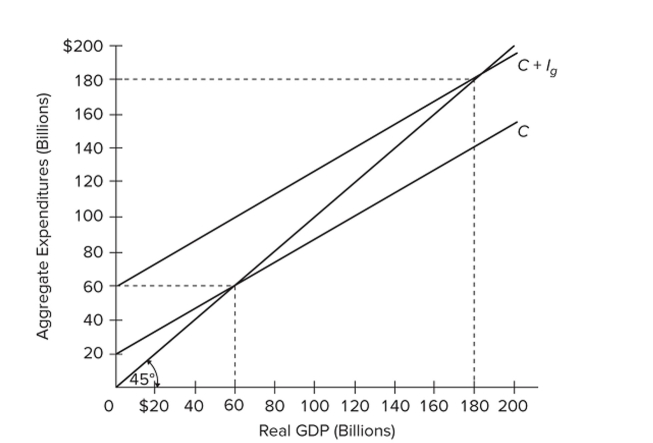 Refer to the diagram for a private closed economy. In this economy, investment
Refer to the diagram for a private closed economy. In this economy, investment
A) decreases as GDP increases.
B) increases as GDP increases.
C) is $40 billion at all levels of GDP.
D) is $60 billion at all levels of GDP.
Correct Answer

verified
Correct Answer
verified
Multiple Choice
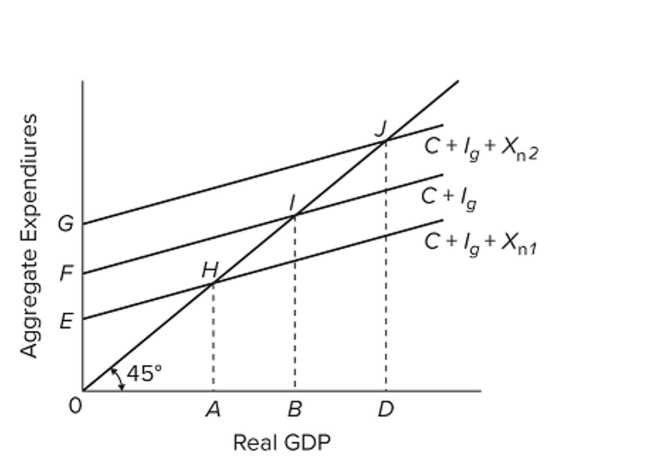 Refer to the diagram. The change in aggregate expenditures as shown from to might be caused by
Refer to the diagram. The change in aggregate expenditures as shown from to might be caused by
A) an appreciation of this nation's currency relative to the currencies of its trading partners.
B) a depreciation of this nation's currency relative to the currencies of its trading partners.
C) a decrease in this nation's price level relative to price levels abroad.
D) a rightward shift in this nation's 45-degree line.
Correct Answer

verified
Correct Answer
verified
Multiple Choice
Other things equal, a serious recession in the economies of U.S. trading partners will
A) have no perceptible impact on the U.S. economy.
B) cause inflation in the U.S. economy.
C) depress real output and employment in the U.S. economy.
D) stimulate real output and employment in the U.S. economy.
Correct Answer

verified
Correct Answer
verified
Multiple Choice
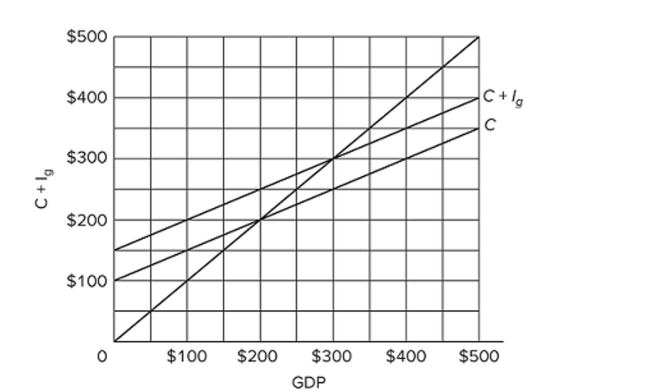 Refer to the diagram for a private closed economy. The equilibrium level of GDP is
Refer to the diagram for a private closed economy. The equilibrium level of GDP is
A) $400.
B) $300.
C) $200.
D) $100.
Correct Answer

verified
Correct Answer
verified
Multiple Choice
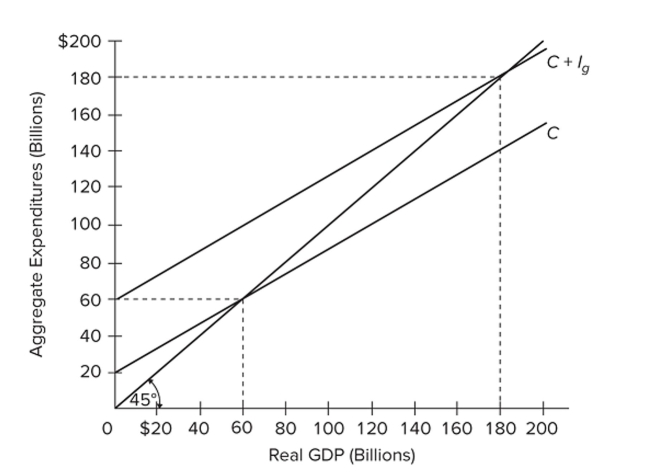 Refer to the diagram for a private closed economy. In this economy, aggregate expenditures
Refer to the diagram for a private closed economy. In this economy, aggregate expenditures
A) do not change as GDP increases.
B) increase by $2 for every $5 increase in GDP.
C) increase by $2 for every $4 increase in GDP.
D) increase by $2 for every $3 increase in GDP.
Correct Answer

verified
D
Correct Answer
verified
Multiple Choice
Imports have the same effect on the current size of GDP as
A) exports.
B) investment.
C) consumption.
D) saving.
Correct Answer

verified
Correct Answer
verified
Multiple Choice
Refer to the tables of information for a private closed economy. The multiplier in this economy is
A) 4.
B) 5.
C) 2.5.
D) 3.5.
Correct Answer

verified
Correct Answer
verified
Multiple Choice
Which of the following statements is correct for a private closed economy?
A) Saving equals planned investment only at the equilibrium level of GDP.
B) All levels of GDP where planned investment exceeds saving will be too high for equilibrium.
C) Planned and actual investment are identical at all possible levels of GDP.
D) Saving equals actual investment only at the equilibrium level of GDP.
Correct Answer

verified
Correct Answer
verified
Multiple Choice
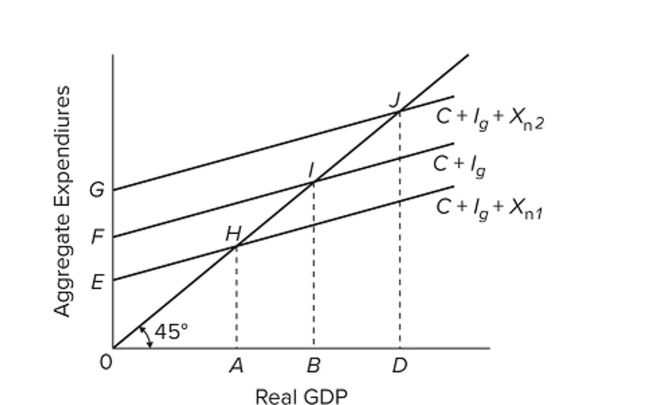 Refer to the diagram. If net exports are , the GDP in the open economy will exceed GDP in the closed economy by
Refer to the diagram. If net exports are , the GDP in the open economy will exceed GDP in the closed economy by
A) AB.
B) AD.
C) FG.
D) BD.
Correct Answer

verified
Correct Answer
verified
Multiple Choice
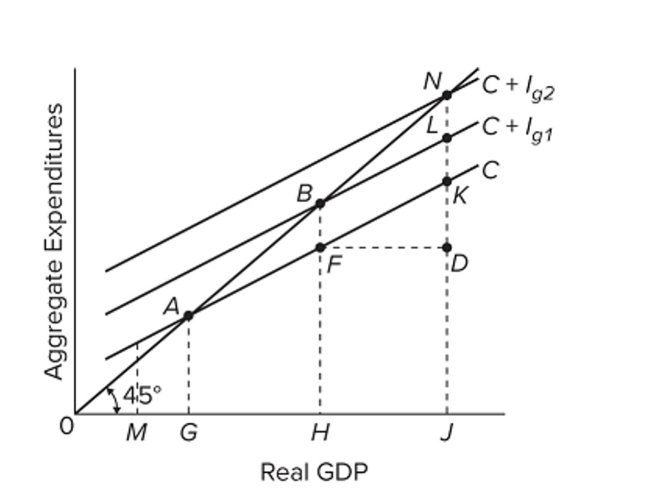 Refer to the diagram, which applies to a private closed economy. If aggregate expenditures are C + Ig2, the amount of saving at income level J is
Refer to the diagram, which applies to a private closed economy. If aggregate expenditures are C + Ig2, the amount of saving at income level J is
A) LK.
B) KN.
C) KD.
D) JD.
Correct Answer

verified
B
Correct Answer
verified
Multiple Choice
At equilibrium real GDP in a private closed economy,
A) the MPC must equal the APC.
B) the slope of the aggregate expenditures schedule equals the MPS.
C) aggregate expenditures and real GDP are equal.
D) planned saving and consumption are equal.
Correct Answer

verified
Correct Answer
verified
Multiple Choice
Refer to the tables of information for a private closed economy. If the real interest rate is 10 percent, the equilibrium GDP will be
A) $100.
B) $200.
C) $300.
D) $400.
Correct Answer

verified
Correct Answer
verified
Multiple Choice
Ig = 80 S = −80 + 0.4Y (Advanced analysis) The equations refer to a private closed economy, where Ig is gross investment, S Is saving, and Y is gross domestic product (GDP) . In equilibrium, saving will be
A) $40.
B) $120.
C) $60.
D) $80.
Correct Answer

verified
Correct Answer
verified
Showing 1 - 20 of 126
Related Exams